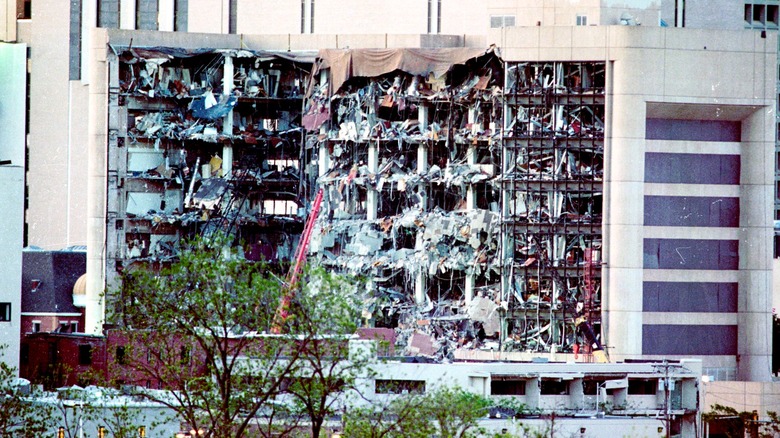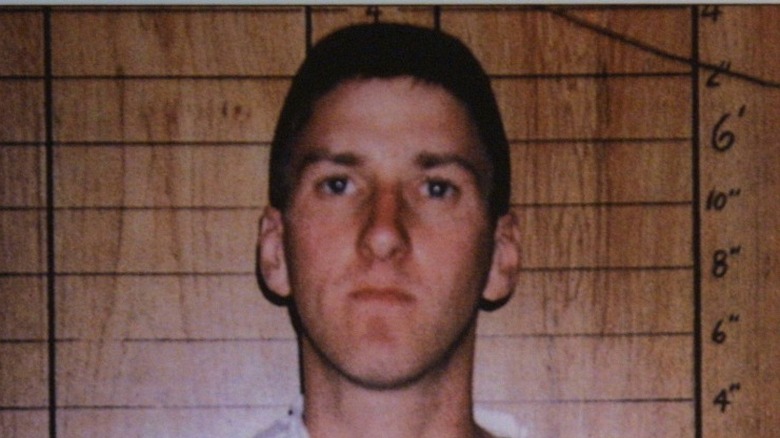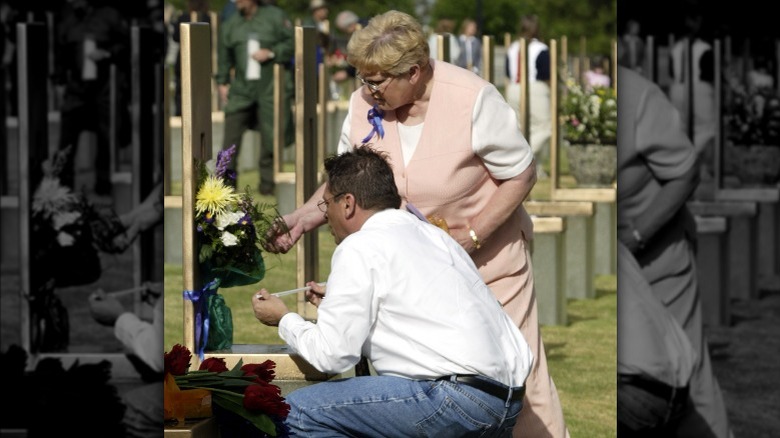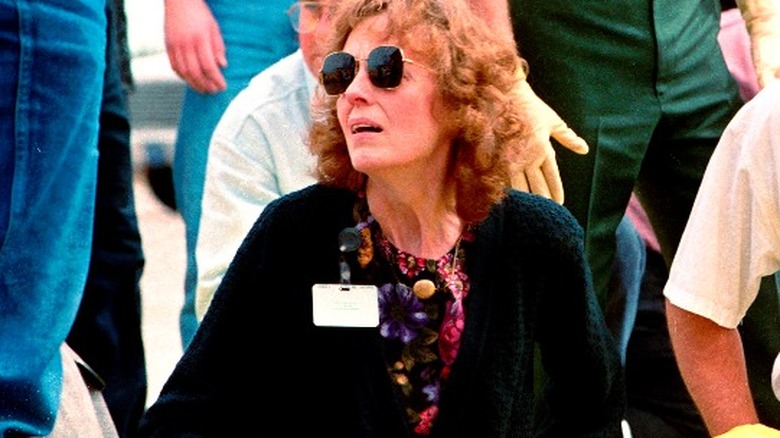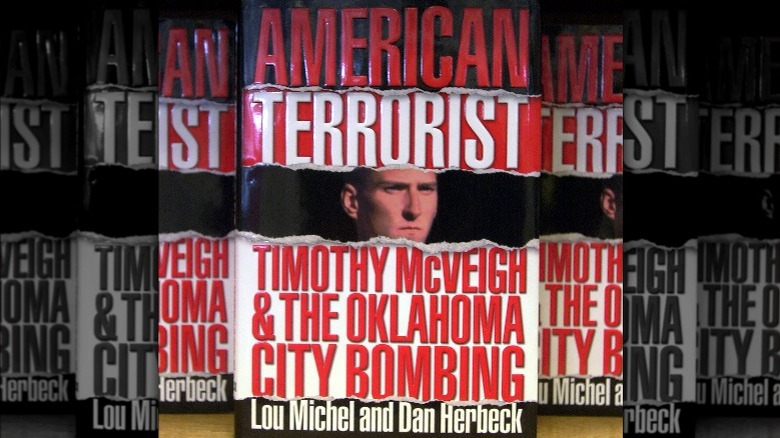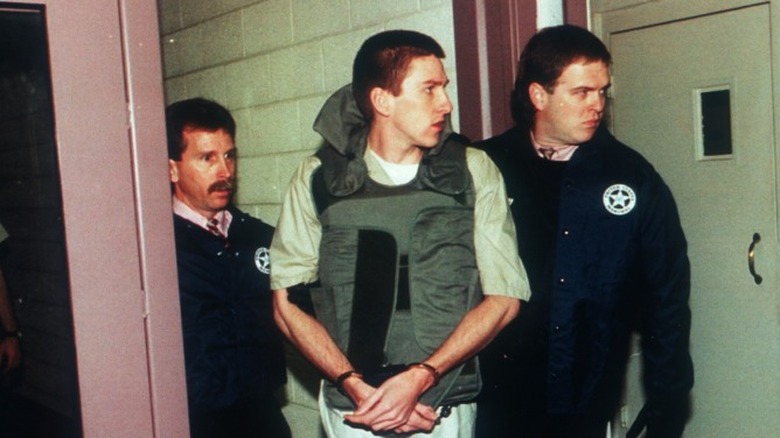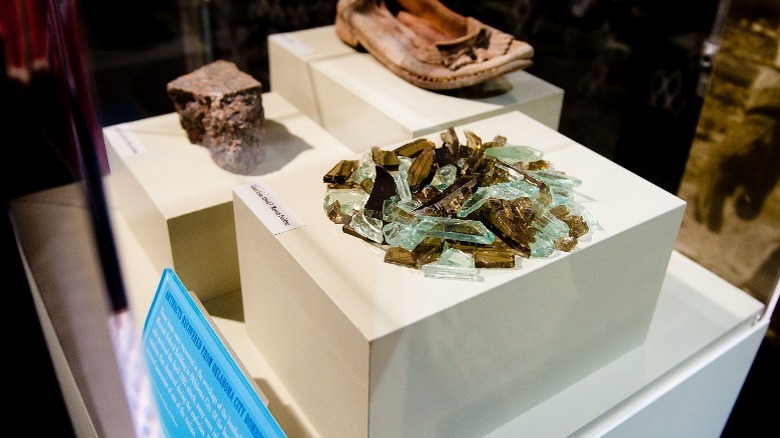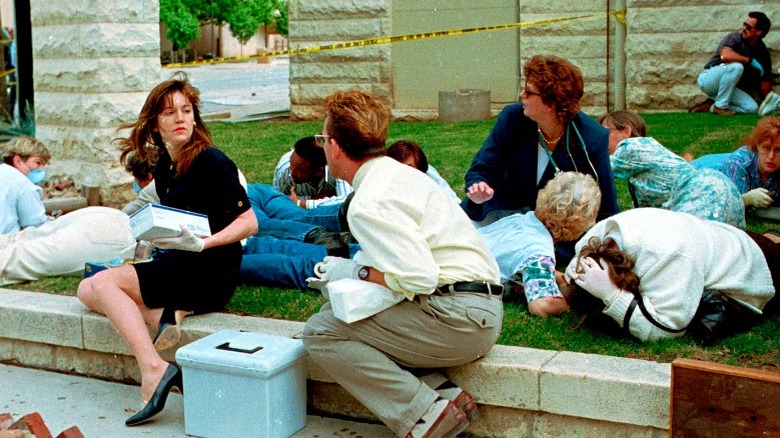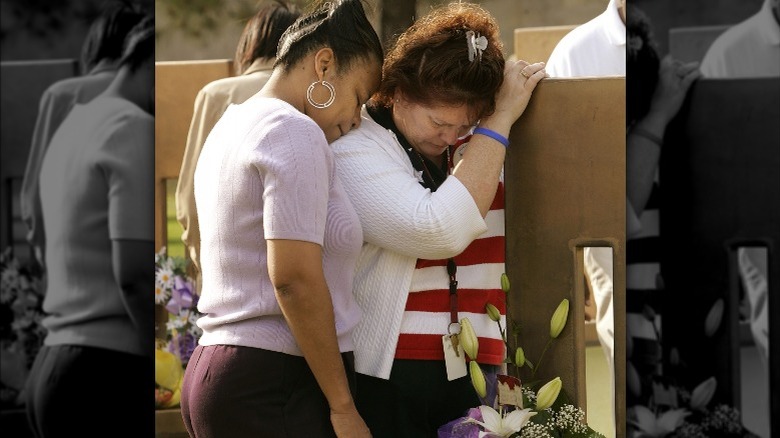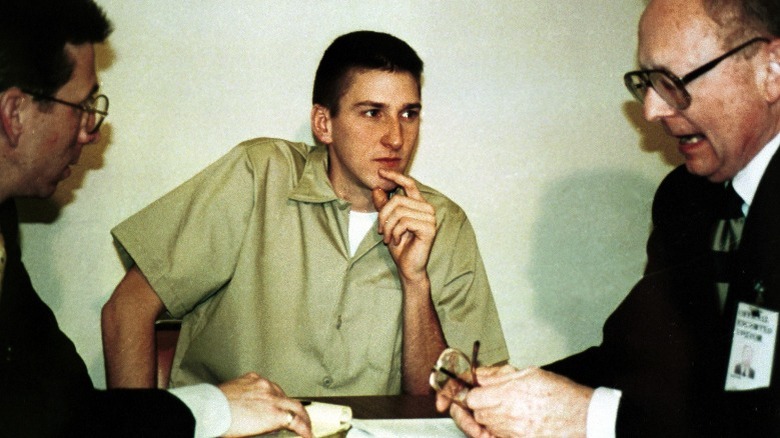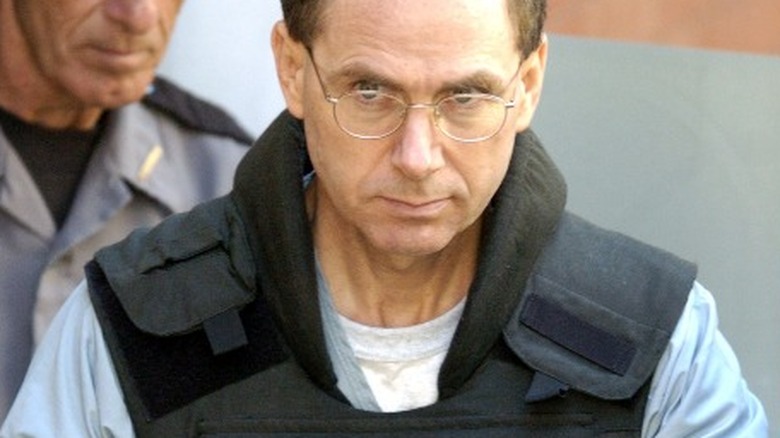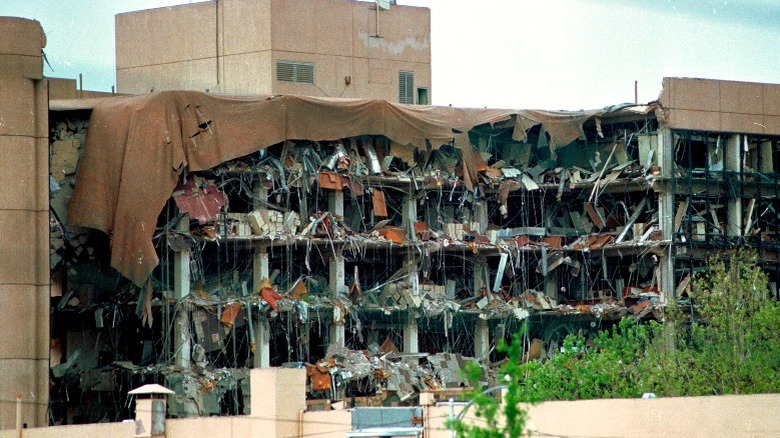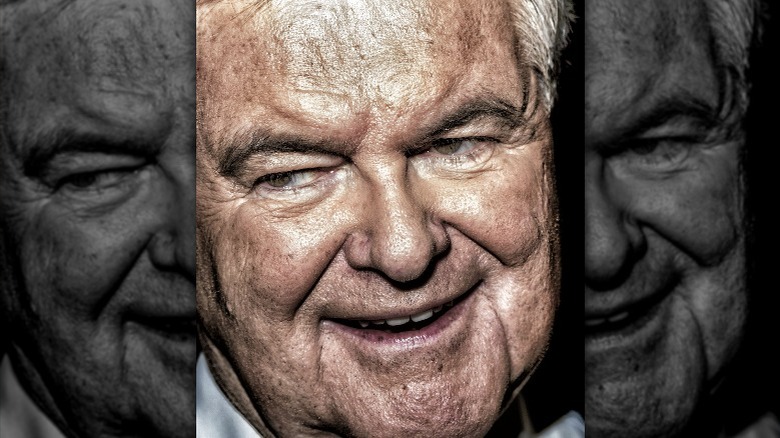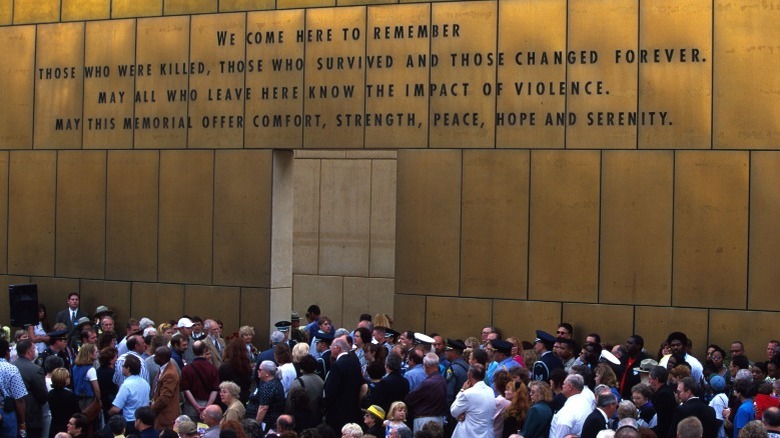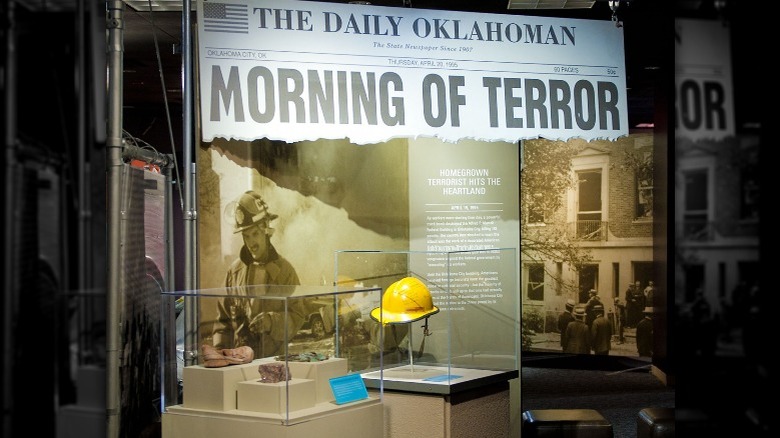Chilling Details From The Oklahoma City Bombing
On April 19 1995, the world changed forever. That morning, Timothy McVeigh, a disgruntled 26-year-old security guard, drove a rented truck to downtown Oklahoma City and parked it in front of the Alfred P. Murrah Federal Building (via the FBI). Inside the truck was a makeshift bomb made out of fertilizer and gasoline, attached to a timed fuse, and capable of mass destruction. Precisely at 9:02 a.m., minutes after McVeigh had successfully made his escape, the bomb exploded, tearing apart the building, and killing or injuring many of those inside.
Immediately, the FBI and local police started to investigate the bombing, and they quickly deemed it a terrorist act. Soon, McVeigh was a prime suspect in the bombing, along with his co-conspirators Terry Nichols and Michael Fortier. Eventually, all three of them were sentenced to prison, and the federal government executed McVeigh in 2001. Many consider this to be the biggest domestic terror attack in American history. These are the chilling details from the Oklahoma City bombing.
The bombing was carried out by three Army veterans
All three of the men convicted for their role in the bombing — Timothy McVeigh, Terry Nichols, and Michael Fortier — were all previously members of the U.S. Army. All of them had enlisted in the Army in 1988, and they met each other while in basic training at Fort Benning, Georgia (via Famous Trials). Nichols was 13 years older than both McVeigh and Fortier, and he was McVeigh's platoon leader. Both Nichols and McVeigh served in the Persian Gulf War, where McVeigh earned a Bronze Star, before they both left the service after failing to make it into more prestigious units.
After they left the Army, all three of them continued to spend time together. They all harbored anti-government views, and Nichols and McVeigh were infuriated by the 1993 siege at Waco. Nichols had even attempted to renounce his U.S. citizenship the year prior, in a hostile letter sent to a state agency over his hatred for the government.
In late 1994, McVeigh and Nichols started planning the Oklahoma City bombing, and that October, McVeigh laid out the initial plans in Fortier's living room. However, Fortier refused to aid McVeigh in building the homemade bomb or acquiring the getaway car. Fortier later intended to sell the movie and book rights of his version of the story for "a cool mil," and vowed never to testify, but this didn't materialize and he was cooperating with police within weeks.
19 children died
The Oklahoma City bombing was one of the deadliest terrorist attacks in U.S. history. According to the Oklahoma State Department of Health's official report, 167 people died in the attack, including 19 children. Fifteen of the children were inside of the Alfred P. Murrah Federal Building at the time of the bombing, and were tragically attending a daycare center located on the second floor. The other four children were only at the building because their parents were visitors.
One volunteer rescue worker also died when he was working in the building trying to help survivors. Of the estimated 361 people inside the Murrah Building at the time of the blast, only 42 escaped without injuries. There were also four deaths attributed to people in nearby buildings or walking outside. Many of the people who died had multiple injuries, and most of them perished when the building collapsed on top of them (per JAMA).
According to the Los Angeles Times, not only was the daycare center inside the building destroyed, but a nearby YMCA with a babysitting facility was also partially damaged, injuring some of those inside — including babies as young as 18 months old. Witnesses described a chilling sight of many injured and deceased children among the wreckage, and over two-dozen babies were still missing by the end of the day.
The bombing injured over 680 people
In addition to the 167 deaths in the bombing, there were 684 recorded injuries. According to the Oklahoma State Department of Health's official report, an astounding 447 people were admitted to nearby hospitals with injuries, but fortunately, over 80% of them were treated in emergency rooms and soon released. Of those who remained hospitalized with injuries, almost all of them had soft tissue injuries like abrasions and contusions, over half had fractures and head injuries, and significant numbers of people had severe lacerations that involved vital organs, tendons, or nerves. A quarter of the injuries were suffered by people who were in buildings surrounding the Alfred P. Murrah Federal Building — the target of the bomb.
Most of the injuries were the result of flying glass and debris from the blast, as well as collapsed ceilings (per JAMA). Many of the survivors reported issues similar to PTSD over a year and a half after the bombing.
Two people were unknowingly fishing near the bomb when it was being built
On April 17, 1995, Timothy McVeigh, along with an unidentified accomplice, rented the Ryder truck used to blow up the Alfred P. Murrah Building from Elliott's Body Shop and Ryder Truck Rentals in Junction City, Kansas (per Famous Trials). Over the next two days, the truck made its way through downtown Oklahoma City, where it finally parked in front of the Murrah Building around 8:50 a.m. on April 19. Several witnesses saw McVeigh and a passenger in the van, but the passenger has never been identified — if one ever existed.
Inside the van was one of the biggest homemade bombs ever assembled in peacetime. According to Lou Michel and Dan Herbeck in their biography of Timothy McVeigh (pictured above), "American Terrorist: Timothy McVeigh and the Oklahoma City bombing," McVeigh planned for the bomb to be 7,000 pounds and capable of a massive explosion. The actual bomb ended up consisting of over 1,200 pounds of liquid nitromethane and 5,400 pounds of ammonium nitrate fertilizer, rigged inside several 55-gallon barrels.
McVeigh and Terry Nichols assembled it while parked at Lake Geary, as a man and his son unknowingly fished in the lake just 25 yards from the shore closest to them. They had arrived early in the morning and launched their boat in the water while McVeigh nervously peeked out at them from the back of the truck. McVeigh later stated that he was prepared to kill them, if needed.
Timothy McVeigh was initially arrested on unrelated charges
Authorities had the culprit behind the Oklahoma City Bombing in their custody within 90 minutes of it happening, but they did not realize it for days. After Timothy McVeigh had lit the fuses for the homemade bomb inside his rented truck, he calmly walked away and got into the driver's seat of a 1977 Mercury Marquis (per Famous Trials). He drove away from the city and got onto Interstate 35, heading towards Kansas. However, McVeigh had removed the Marquis' Arizona license plate the Sunday before, according to "American Terrorist: Timothy McVeigh and the Oklahoma City bombing," and this proved to be his undoing. Oklahoma State Trooper Charles Hanger was patrolling the highway, and he pulled over McVeigh after noticing the tag was missing.
According to Hanger's testimony, after pulling over McVeigh and approaching the window, he noticed a gun under McVeigh's arm. He immediately removed McVeigh from the car at gunpoint, handcuffed him, and placed him in his patrol car. Hanger arrested McVeigh and charged him with several things, including transporting a loaded firearm in a motor vehicle and unlawfully carrying a weapon. While McVeigh was still sitting in a jail cell in Perry, Oklahoma on the weapons charges, authorities discovered that he was a prime suspect in the bombing and quickly had him transported into federal custody (via Famous Trials). That evening he was arraigned, and a week later he was ordered to be held without bail. McVeigh was never released from custody again and was executed in 2001.
The FBI reviewed nearly 1 billion pieces of evidence
In their relentless quest to bring Timothy McVeigh, Terry Nichols, and Michael Fortier to justice, the FBI conducted an extraordinary investigation. According to their official page on the bombing, the FBI conducted over 28,000 interviews, followed approximately 43,000 leads, and collected 3.5 tons of evidence. They also searched through millions of hotel, truck, and airline records — over 1 billion pieces of evidence were studied in total.
The effort was spearheaded by FBI Special Agent Barry Black, who led a team of over 1,400 investigators. Black was personally responsible for finding one of the biggest clues in the investigation: He found the rented truck's VIN on a damaged piece of its axle, which eventually led to Black tracking it back to where it was first rented in Kansas. This allowed the FBI to gather a composite sketch of McVeigh, which they immediately circulated throughout the country. A former coworker of McVeigh saw the sketch and positively identified him as the suspect. Authorities realized they already had him in custody on unrelated state charges, and they placed him in federal custody within days (via Famous Trials).
It took over a month to recover all the dead
As soon as the explosion occurred, bystanders and rescue workers immediately went to work trying to save lives and help trapped victims in the ruined Alfred P. Murrah Federal Building. According to the executive summary of the Oklahoma City Police Department's After Action Report, all of the active and off-duty police, fire, and medical workers who were available in the area responded to the explosion. Local hospitals and the Tinker Air Force Base sent crews to assist the workers already on the scene, and aid workers set up temporary morgues in several locations.
By midday, Governor Frank Keating had declared the site a disaster area, and FEMA task forces were activated. Over 324 buildings were damaged, which required the removal of more than 460 tons of debris. It took 17 days for rescue workers to find the first 165 victims in the rubble, and they had to wait over a month until April 23 to recover the final bodies that were in unstable areas. On May 30, workers found a severed leg, leading to questions about whether there was another unidentified victim. Members of the media were caught trespassing into the blast area several times, and many police officers were injured after they inhaled smoke from working in the building during the recovery.
Police set up morgues in a daycare playground and a church
According to the Oklahoma City Police Department's After Action Report, after the bombing, authorities scrambled to set up aid centers and morgues for the constant stream of victims coming out of the devastated Alfred P. Murrah Federal Building. In one of the most heart-wrenching details from the report, it notes they set up an initial temporary morgue on the playground of the building's daycare. Investigators who were on the scene helped set up the morgue, due to the initial shortage of emergency workers.
The temporary daycare playground morgue was quickly replaced by one located at the First Methodist Church, which was just east of the building. The church would then remain as the prime mortuary throughout the investigation. While emergency personnel were moving bodies from the daycare to the church, rescue crews reported finding what they suspected was another explosive device in the rubble. Police immediately directed the building to be emptied, but thankfully the bomb threat was cleared within an hour, and crews were able to get back to work. There was also another morgue in a temporary field hospital that had been set up in the local postal office, but all bodies were eventually moved to the church, which had become the main morgue.
Timothy McVeigh never apologized or spoke during his execution
On June 2, 1997, just over two years after the bombing, Timothy McVeigh was convicted in court for his role. A jury found him guilty of all 11 counts he was tried on, including conspiracy to use a weapon of mass destruction, use of a weapon of mass destruction, and multiple counts of first-degree murder (via Famous Trials). A month later, at a federal courthouse in Denver, Colorado, Judge Richard P. Matsch sentenced McVeigh to death, according to Famous Trials. During the sentencing, McVeigh declined to say anything, other than quoting a dissenting opinion from former Supreme Court Justice Louis Brandeis: "Our Government is the potent, the omnipresent teacher. For good or for ill, it teaches the whole people by its example."
Almost exactly four years later, on June 11, 2001, the federal government executed McVeigh by lethal injection. According to The New York Times, McVeigh was officially pronounced dead at 7:14 a.m. in the federal prison of Terre Haute's execution chamber. During his execution, McVeigh never apologized or even spoke a word. He gave prison officials a handwritten copy of William Ernest Hensley's poem "Invictus" for his last words. Over 240 people witnessed the execution, including several people who were either involved in the blast or lost a loved one in it. McVeigh was the first federal prisoner to die by execution since Victor Feguer in 1963.
Terry Nichols was spared the death penalty
Though Terry Nichols was a co-conspirator in the Oklahoma City Bombing, he did not face the same punishment as the main culprit, Timothy McVeigh. According to Famous Trials, Nichols helped McVeigh with all of the planning and organizing up until the day before the bombing. Yet, when the bombing actually happened, Nichols was at home in Kansas with his family. Still, investigators quickly put Nichols on their list of suspects, and he surrendered to them voluntarily within days. Three weeks later, federal officials formally charged Nichols in connection with the bombing, after their search of his home revealed he had recently purchased a massive amount of ammonium nitrate — one of the key ingredients in the bomb.
In a split verdict, a federal jury convicted Nichols of the bombing in late December 1997. He was found guilty of involuntary manslaughter and conspiracy to use a weapon of mass destruction, but the jury acquitted him of several other charges, including murder and using a weapon of mass destruction (via the Washington Post). Jurors could not agree on sentencing Nichols to death, so a judge instead sentenced him to life in prison without parole.
Six years later, in August 2004, Nichols was again spared the death penalty, after being convicted on state charges related to the bombing. In lieu of the death sentence, the presiding judge sentenced Nichols to 161 consecutive life sentences (per The New York Times).
One of the co-conspirators was released from prison and is still free
While Timothy McVeigh and Terry Nichols are infamously associated with the Oklahoma City Bombing, there was another conspirator who was also convicted for his role: Michael Fortier, a former Army buddy, who was found guilty for his role in aiding McVeigh and Nichols. On May 27, 1998, Fortier was sentenced to 12 years in prison by a federal judge (per the Washington Post). He was convicted for his failure to warn authorities about the bombing after McVeigh had tipped him off about it one year earlier.
Victims of the bombing and their families were upset that Fortier was given such a light punishment, in contrast to the death sentence for McVeigh, and a life of incarceration for Nichols. During the sentencing they spoke for three hours, giving victim impact statements that repeatedly brought Fortier to tears. Fortier was one of the star witnesses for the prosecution in both McVeigh's and Nichols' cases, and prosecutors asked the judge in Fortier's case to reduce his possible sentence due to his "meaningful and valuable" help in putting away McVeigh and Nichols — which he did.
Less than 11 years later, Fortier was released from prison and immediately placed into federal witness protection, where he is still thought to be today (per the Southern Poverty Law Center). His wife, Lori, was also involved in the planning of the bombing, but she was never prosecuted due to a provision in Fortier's plea bargain.
Congress tried to fast-track death penalty cases over the bombings
America was outraged and furious over the bombing, and its devastating human cost. Many people, including President Bill Clinton, publicly suggested the possibility of a death sentence for Timothy McVeigh. As a response, the following year Congress passed the Antiterrorism and Effective Death Penalty Act of 1996 (per Columbia Law School). The bill had initially been introduced in early 1995 by Newt Gingrich (pictured above) and the Republican controlled House of Representatives. They did so on the heels of a major electoral victory the previous November, after they had campaigned on creating a more effective death penalty. Following the bombings, the death penalty bill was immediately fast-tracked through Congress, by its attachment to an antiterrorism bill.
According to the Cornell Law Review, the bill was proposed in order to "eliminate interminable delays and fast track death [sentences]." It also reformed provisions regarding habeas corpus, by limiting when a federal judge could issue a writ of habeas corpus to state prisoners. Previously, there had not been a federal execution since 1963. However, after the bill passed, three prisoners were executed in a two-year span from 2001 to 2003 — including McVeigh. Many critics have argued that the bill was pushed through hastily in response to the bombings, and the "drastic cuts to federal habeas corpus review" are unfortunate effects (per Columbia Law School).
Every year people gather at the site of the bombing
For the residents of Oklahoma City who were there during the bombing, April 19 holds a special meaning. They gather annually on this date — the anniversary of the bombing — to remember loved ones and honor victims of the tragedy (via Oklahoma News 4). They hold a 168-second-long moment of silence — one second for each victim who died in the explosion. Most of the employees at the building worked for the government, including members of the Drug Enforcement Administration (DEA) and U.S. Secret Service, as well as recruiters for the U.S. Army and Marines.
On April 19, 2000, on the fifth anniversary of the bombing, President Bill Clinton dedicated the Oklahoma City National Memorial on the former site of the Alfred P. Murrah Federal Building. The memorial is dedicated to those who were killed and those who survived the bombing, as well as first responders and volunteers who participated in the rescue effort. The following year, President George W. Bush dedicated the memorial museum, and the city hosted the first annual Oklahoma City Memorial Marathon, held every year since, in another tribute.
Conspiracy theories hit the internet within weeks
In the aftermath of the Oklahoma City bombing, misinformation started to spread like wildfire, and according to The Washington Post, the internet was flooded with conspiracy theories over the following year. Some of the theories tied President Bill Clinton, or Oklahoma Governor Frank Keating, or both, to the bombing, and others blamed Jewish people and organizations for the destruction. Per the Washington Post, most of the theories revolved around the FBI withholding evidence from the public, and suggested the mainstream media was willingly participating in the scheme. Fake affidavits, supposedly from officials with the Department of Justice, started to circulate, and some suggested that Timothy McVeigh and Terry Nichols were being controlled by the government as "zombies."
As recently as 2019, there were still theories spreading on social media that Hillary and Bill Clinton were connected with the bombing (via PolitiFact). One theory suggested that Hillary Clinton was going to be prosecuted in 1995 as part of the Whitewater controversy, but the case files were located in the federal building at the time of its explosion, thus conveniently destroying all of them and preventing her from being prosecuted. Not only is there no evidence that the Clintons were directly connected with the Whitewater controversy itself, but there is also no evidence that any of the case files were in the building during the explosion: PolitiFact considered the conspiracy theory to be completely false.
